Algonquin “Billabong” Adventure 1994
|
Access #27: Cedar Lake, Petawawa River, Catfish Lake, Sunfish Lake, Hogan Lake, Little Madawaska River, Lake La Muir, Burntroot Lake, Longer Lake, Big Trout Lake, Robinson Lake, Whiskeyjack Lake, Catfish Lake |
|
|
Voyageurs: David Mazurkiewicz and Scott Smith Duration: 12 days (May 14 – 25) Total distance portaged: 17,125 m |
Travel distance: ~ 90 km Elevation change: 96 m |
|
Day 1 – May 14 St. Catharines, Ontario – 5:30 a.m. .. After a quick pit stop at McDonald’s for our traditional pre-trip breakfast we were on the road, en route to the town of Brent on Cedar Lake. Roughly 6 hours of driving took. us through the towns of Sundridge, South River, Trout Creek and Mattawa. We finally hit the access road to Brent. If one takes exit 94 at Callander over to hwy 17, one can by-pass North Bay and save driving time. The trip east along hwy 17 through Mattawa and along the Ottawa River is quite scenic. It's my favourite part of the drive. The 40 km access road into Brent is a long and winding affair. At the time of this trip, the permit office was located at the 18 km marker. However a new structure was built in 2005, conveniently located 1 km in off the highway. About 3 km’s before Brent, we pulled over to check out the Brent Crater and climbed the observation tower. There's a magnificent view of Tecumseh and Gilmour lakes from the top of the platform. 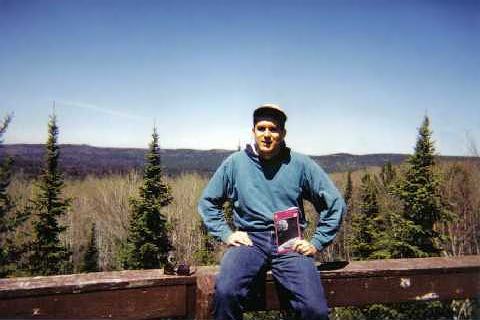 Dave at Brent Crater tower. After this brief stop, we continued along the road to the Brent store .. our final destination. Just before you hit the store, there's a sign that welcomes you to “downtown Brent”. Don’t blink. You might pass it by. The town itself consists of only a few cabins and the store, which is also home to Algonquin Outfitters. Take the time to browse the store's many artifacts that reveal much of Brent’s history including that of the railway, which was once the town’s lifeline. Trains of over a hundred cars would rumble through town, seemingly every hour, even at the time of this trip. A few years’ later and the railway was abandoned. With the tracks torn up, it marked the end of an era in Brent’s history. After loading the canoe at the dock, we were on the water at 1:45 p.m. It was a picture-perfect day for early May. It was sunny and hot. We quickly shed our jackets to enjoy the summer-like conditions. At the dock, you can clearly see the outflow of the Pettawawa River on the far shore spilling out into Cedar Lake. Cedar is surrounded by some beautiful vistas and on this day it was unusually calm, making the crossing much easier than anticipated. The first portage of 715 m is well traveled with a gradual uphill grade and it was a good warm-up for what lie ahead of us. A short paddle later and we did the 255 m portage at the large falls or what we refer to as “Niagara Falls”. If you consult the Canoe Routes Map, the 2,345 meter portage doesn’t look all that intimidating. But I can assure you, it is very unforgiving .. even for the experienced Voyageur. This is definitely one of the most challenging portages I’ve ever done in Algonquin. On this carry, you climb most of the 80 meters difference in elevation between Cedar and Catfish. It’s an uphill grind all the way and it really takes a toll on you physically and psychologically. With light packs and determination, it can easily be done in a single carry. At the hilltop, you pass by a canoe rest on your right that has a sign that reads “Unicorn Hill”. I’ve always wondered what the significance of the name is and hopefully one day I’ll discover its meaning. Further along the trail we encountered two men headed out of the park and one of them had a full leg splint. I’m not sure what had caused his misfortune, but it was clearly a struggle for them both. They were packing light and it became apparent that they must have abandoned their gear at some point in order to lighten the load. After offering assistance, which was graciously declined, we continued down the pathway. When the water finally came into view it was like an oasis appearing before us. After shooting across a small pool with very strong current, we did the 170 meter carry into Narrowbag Lake. This lake is a long narrow passage deserving of its name. We noticed several fish rising to the surface before reaching the 80 meter portage into Catfish Lake. However, we didn't wet a line. It’s very enjoyable navigating the narrows, which contain many unusual rock formations and root systems. You simply flow with the current, eventually spilling out into the NE arm of Catfish. Night was falling as we paddled down the east shore of Catfish, frantically searching for a campsite. Much to our dismay, all sites were occupied and the situation suddenly became desperate. However, luck was with us as we approached the south shore, and at 8:00 p.m. we laid claim to the last available piece of real estate on Catfish. Exhausted from a long day, we set up camp and made an evening fire. Day 2 – May 15 We woke to an overcast day and reluctantly got up to make breakfast consisting of scrambled eggs and bacon. We decided to start putting some distance behind us, so we broke camp for Hogan Lake. It started to drizzle rain as we entered the grassy marsh at the mouth of Sunfish Lake. After navigating some deadheads and traversing its width, we hit the landing at the 1,105 meter portage to Newt Lake. We closed off Newt in a hurry, then carried the 750 meter distance into Manta Lake. Manta, another small lake, quickly became an afterthought as we arrived at the 1,945 meter portage into Hogan Lake. The carry to Hogan seemed endless as we continued to eat up the distance. Along the trail, we noticed snow in the well-shaded low-lying areas. We simply couldn’t resist and stopped just long enough to build a small snowman for the next passers by to enjoy. We also tossed a few snowballs around for the fun of it. At about the 1,500 meter-mark a narrow inlet of Hogan comes into view through the trees on the right. The trail continues on for a while, so just put your head down and you will eventually find the water. After a quick breather, we loaded our packs in the canoe and slipped quietly into Hogan Lake. The lakes surface was like a sheet of glass, as the canoe sliced effortlessly through the water leaving behind a tiny wake. We set a course for the south shore, in hopes of finding a campsite to call home for the night. As we settled into a steady paddle stroke, it was evident that Hogan was bustling with activity. The drone of motorboats could be heard in the distance, which put a damper on the atmosphere for us camping purists. As we paddled west along the south shore and as night was falling, we noticed all the campsites in view were occupied. As we passed by the next site, two men came out to greet us .. offering to share their site if we couldn’t find one. Their offer was tempting. But we decided to take our chances, so we continued on our way. A few hundred meters further around the point and we found the only vacant campsite left on the west half of the lake. It was across from an impressive rock face and adjacent to a quiet bay. We then declared the campsite as ours and set up camp. I started cooking dinner, while Scott tried his luck casting from shore. After only a few casts, Scott hooked into a nice Brook Trout that exploded on the still surface with an acrobatic display. It was a beautiful fish and capped off a perfect day. 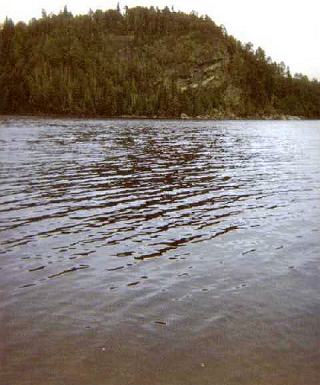 Rock Cliff on Hogan Lake. Day 3 – May 16 It rained all night, with a steady pitter-patter of raindrops on the tent. It was good for sleeping, but we awoke to puddles in Scott’s new tent. This was most upsetting. However, 12 years later we still put this tent to use on our annual trips. It was a very crisp and cold morning, so we had oatmeal and hot chocolate to warm up. After breakfast, we stockpiled some wood to ensure we could keep ourselves warm. We dug our heels in, as the rain was relentless and we prepared for the worst. While gathering firewood, we made an unusual discovery. Much to our surprise, we found a stove and several other artifacts scattered all around our campsite. It dawned on us that the two men we met on the Catfish trail must have stayed here on this exact site and left these items behind. They simply could not carry this gear out due to the one man’s injury. They even left behind a brand new fishing lure, which of course we put to good use. We decided to leisurely paddle the narrow bay adjacent to our site, fan casting towards the timber near shore. Scott’s efforts were met with success as he boated two more nice sized Brookies to put on the stringer, before the bite eventually turned cold. As we hit the shore back at camp, I tried a few casts from the rock in front of our campsite. A few casts towards the point and wham! I landed my first Brook Trout of the trip. Scott was quick to emphasize how much larger his fish were and it was probably just insecurity on his part. As the fishing was picking up and the outlook was positive, we decided to stay the night. We ate freshly caught Brook Trout for dinner along with some potatoes, which tasted oh so good! After a warm evening fire, we turned in at 9:30 p.m. Day 4 – May 17 The morning was so cold I didn’t want to leave the comfort of the tent. Scott was the first up (as usual) and I reluctantly followed him. It was still overcast but the rain held off, so we decided to break camp and head west towards the Little Madawaska River. After battling the whitecaps on Hogan, we finally arrived at the landing of the 685 meter portage to Lake La Muir. 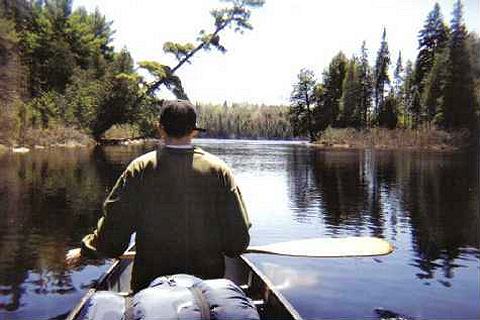 Little Madawaska River. As we neared the put-in to La Muir, we had to carefully negotiate the last 100 meters or so. It was covered in 6 inches of water. After assessing the situation, we decided to load our gear into the canoe and drag it to the dock. The water was simply not deep enough to paddle. To add insult to injury, we both received soakers past our ankles.  Dave at La Muir dock. As Lake La Muir opened up before us, we decided to hug the north shore which was calm and well protected from prevailing winds. About 1 km down-shore, we passed a few campsites and noticed some fish remains in the shallows. It was a good indication that fishing was good here. However, La Muir was simply a travel lake for us. As we approached the NW corner of the lake, the 735 meter portage into Redpine Bay came into view. Negotiating this carry was easy .. aside from some muck and scattered boulders on the landing. In no time, we reached the sparkling waters of Redpine Bay. After crossing the small bay, we took the first campsite out from the portage, as it looked inviting. As usual, I set up camp while Scott took up his regular position on shore were he took cast after cast. Scott caught yet another Speckled Trout .. this one a bit smaller in size but spunky. After settling in to our campsite, we took the canoe for a leisurely paddle around the bay to unwind and fish. I was startled as my rod slammed back as I latched onto a good fish, which I lost just as quickly while attempting to hoist it into the boat. Much to my dismay, my lightweight 4 lb. test line broke under the pressure. To add further to my woes, the fishing turned cold and we returned to our camp empty handed. We had to settle on hot dogs for dinner. Day 5 – May 18 We woke to a dreary, overcast sky over Redpine Bay .. a theme that was becoming all too familiar. Again the air was crisp, but not as cold as the previous days. We were hungry, as we always seem to be, so we cooked the last of the bacon along with some oatmeal for breakfast. It was time to pack up camp. I started, while Scott once again tried his luck casting from shore. Luck was with him, as he hooked into a monster Lake Trout that made his drag scream in defiance. Several minutes later, the fight was finally over and Scott beached the large 10 lb. Lake Trout. After a few quick photographs, this trophy fish was released. With a powerful thrust of it’s tail, it was gone. This was definitely a highlight of the trip. Notice in the photo that the tip of it’s tail was missing .. from spawning perhaps? 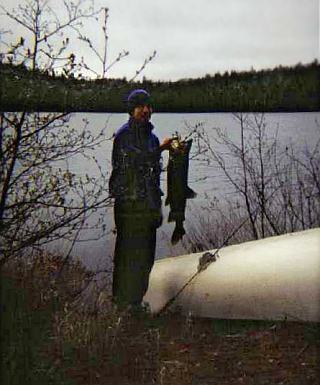 Monster Redpine Bay Laker. After packing up, we were back on the water as the clouds started to break up. This was our first encounter with the sun since Saturday and it felt good. Minutes later, the clouds had all but disappeared to reveal a perfectly blue sky. It was tough to leave Redpine Bay, one of our favourite spots in Algonquin. We paddled west towards the 75 meter portage and this carry seemed more like 150 meters as some extra rapids extended the walking distance. We then skipped across a small pool to the 40 meter portage and into the north narrow section of Longer Lake. 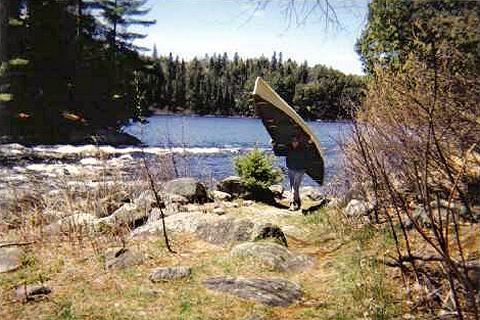 Redpine Bay to Longer. As we rounded the bend, Longer Lake opened up before us. With a stiff wind at our backs, we paddled south towards Big Trout Lake. The paddling was easy and we even managed to overtake another canoe headed in the same direction. We are just way too competitive for our own good. Much to our surprise, this same group turned the tables on us as they passed us on the 300 meter portage leading to Big Trout. We were quite relieved as their canoe veered away from our favourite island campsite, which was our final destination. Our favourite campsite in the NW corner of Big Trout was the same site we stayed at the year before. It features a breathtaking southern view of the rolling hills and beautiful vistas surround the shores of Big Trout. It’s also sheltered from the winds and has good cover to protect from the rain. After setting up camp, we enjoyed some KD (our signature dish) and then headed out onto Big Trout for some fishing. Fish were rising all around us to feed on the Mayflies that would come to rest on the waters surface. But they refused to take our offerings. It was a perfectly calm but cool night, as the sun set on the horizon and all was perfect. We didn’t catch anything that night. But we didn’t care, as this was Algonquin at it’s finest.  Camp View of Big Trout. Day 6 – May 19 It was a mild night. When I awoke, Scott was already out on the water fishing. The sun's warmth penetrated the tent as it was burning the mist off the lake. It was shaping up to be a great day. After climbing out of the tent, I sat on a rock overlooking the lake .. to enjoy the sun. If it wasn’t for a slight breeze, I could have worn shorts. Out on “my rock”, I had some corn flakes for breakfast. Scott paddled into shore at a leisurely pace at around 10:30 a.m. without fish. We then lazed around camp for a few hours. I continued to enjoy the sun and I could sense Scott was getting frustrated with the poor fishing. 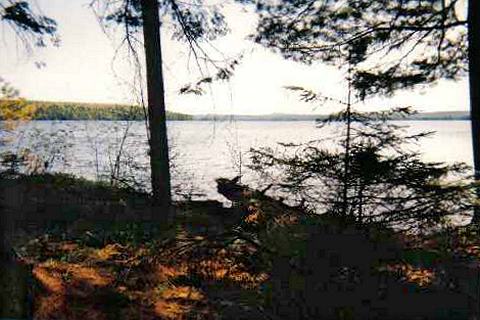 Big Trout Lake. To pass the time, I started carving a small cabin out of a piece of wood. I finished it off by placing a pine twig in a hole, to make it look like a tree. It looked all right. After lunch, we decided to give the fishing on Big Trout another try. A couple hours passed by without any luck, which was quite strange. The year before we'd caught several fish here. It was another frustrating outing to say the least. With the vastness of Big Trout’s waters, we simply didn’t know where to start looking for fish. As a consolation, we cooked up the fish caught the day before, and added some potatoes and onions. Simply delicious! Refusing to give up, Scott went out fishing yet again. I decided to explore the island. It’s a large island with only one campsite on it and a small inlet on the other side. It’s shaped like the letter “C” almost like the island on "Gilligan’s Island". Darkness was falling quickly, when Scott finally came to shore .. again with no fish. We settled in for the night, as Scott wrote about the day’s events in his journal while I listened to my Walkman.  Campiste Driftwood. Day 7 – May 20 I hadn't slept well, but my spirits brightened as the warmth of the sun burned into the tent. I looked out and noticed Scott was already out fishing, as was his usual morning ritual. There was not even a slight breeze and was it ever hot! All was quiet on Big Trout, except for a few canoes headed south. They passed between our island and the neighbouring island. Not long after, Scott returned triumphantly from a morning of fishing with a nice 4 lb. Lake Trout. He was a happy camper indeed. After examining Scott’s catch, I returned to lounging around in the sun. I did this for several hours while Scott took a nap. At 4:30 p.m. we cooked up the fish in Cajun mix along with some rice and it was simply delectable. After dinner, we went for an evening paddle. The bugs were out in full force, swarming all around our heads but luckily not biting. Meanwhile, while trolling, Scott hoisted yet another nice sized Lake Trout into the boat. He later filletted the fish, back at camp. Surprisingly, the bugs were not as bad on shore as they were out on the water. We enjoyed the evening, settling in to our usual routine of a fire and turned in at 11:00 p.m. Day 8 – May 21 We awoke to a beautiful morning, had oatmeal for breakfast and then packed up our camp. This would be the last time we would see Big Trout for another year. We were both sad to leave. 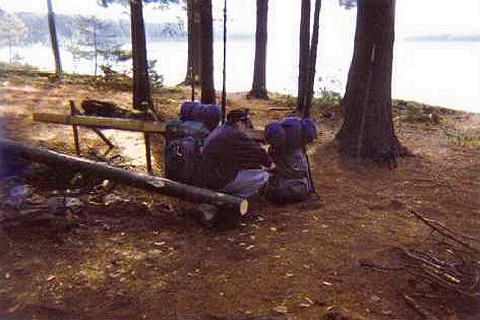 Breaking Camp. At 9:45 a.m. we were on the water, heading north back up to the 300 meter portage, through Longer Lake and over the 40 meter and 75 meter carries into Burntroot. As we passed through the north section of Longer Lake, we surprised a moose grazing in the shallows. It bolted at our presence. 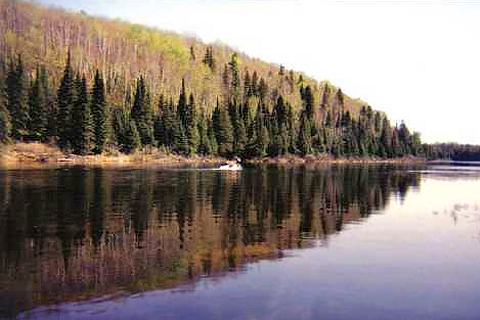 Longer Lake Moose Crossing. We decided to troll to our next campsite, as we were in no hurry. While passing along the north shore of Redpine Bay, Scott’s rod slammed back as he latched onto a nice 5 lb. Lake Trout. This fish was beautifully coloured with an orange tinge on its fins. It was quickly released back to the water, after a quick photo. Trolling to your next campsite is a good way to cover a lot of water and to put the odds in your favour. 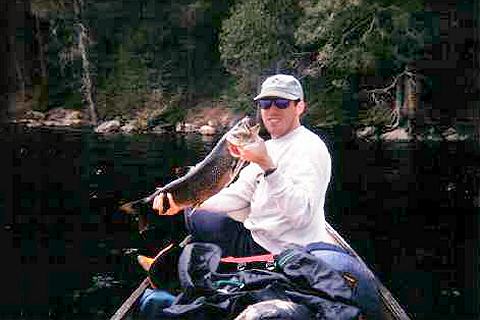 5 lb. Redpine Bay Laker. After a few days’ rest, we were full of energy as we continued north, following the east shore of Burntroot. We set up camp on an island site in the NE corner of Burntroot, close to the Portal Rapids and the portage to Robinson Lake. This site has a fantastic view looking south. It had the luxury of an outhouse and a table, that was perfect for filleting fish. Burntroot seemed like a lonely land and we had it to ourselves, which was fine by us. We had lunch and crashed for a few hours in the tent which felt like a sauna from the heat of the sun. Scott later fried up the fish from the night before in Cajun mix, which hit the spot. In the evening, we went out fishing .. covering the shoreline to the NW of the island. However, we returned to camp without any fish. Once again, Scott was losing his patience with the fishing; so we decided to travel to Whiskeyjack Lake the next day. As Scott studied the map, carefully planning the route, I listened to my dance mix ’93 tape on my Walkman. The batteries died soon after and we turned in for the night. Day 9 – May 22 Happy birthday to me! It was my 24th. We broke camp at sunrise and skipped across a short expanse of water to the 1,285 meter portage into Robinson Lake. We navigated the portage with ease and launched our canoe into the still waters of Robinson. This was simply a travel lake for us, so we didn’t take time to explore or fish. As we quietly skimmed across the glassy surface of Robinson, we passed by an impressive rocky island before arriving at the landing to Whiskeyjack. Robinson Lake looked inviting, but we didn’t have enough time to stay. The second portage of the day was a short 25 meter carry over to Whiskeyjack or “Jimmyjack” as Scott called it. 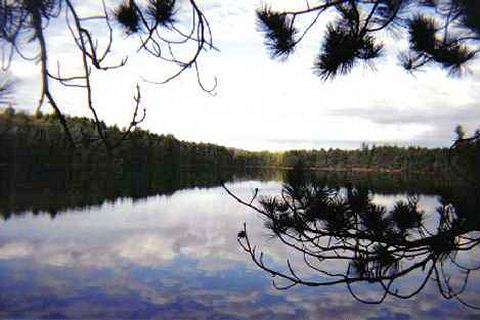 Whiskeyjack Lake. Whiskeyjack Lake is known as one of Algonquin’s headwater source lakes, with its distinct green sparkling water. I’ve heard many stories of good fishing here, and I was anxious to give it a try. Whiskeyjack is a relatively small lake but is very beautiful and secluded .. definitely worth the extra effort it takes to get here. After setting up the tent, we crashed for a few hours to rest. We woke to the buzzing of mosquitoes swarming all around the outside of the tent. We would flick them from the inside of the tent in amusement. However, this was no laughing matter. The bugs were simply horrible and completely blindsided us. Scott decided to take his chances and ventured out to try some fishing from shore. Casting was challenging as a stiff onshore breeze was picking up. Luckily it seemed to keep the bugs away for the time being, but made it difficult to cast. Persistence soon paid off for Scott, as he hooked a nice 16 inch Brookie that danced on the end of his line. We then decided to try our luck from the canoe, as we prepared to loop around the lake. However, the wind forced us to change our plan, so we kept at it from shore. Over the course of the next few hours, and several casts later, Scott managed to catch two more nice Whiskeyjack Brook Trout. 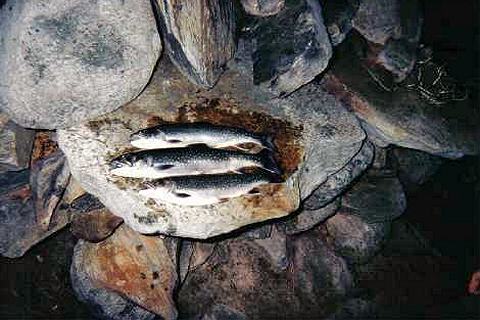 Fine Catch of Whiskeyjack Specks. As the afternoon wore on we sheltered ourselves in the tent from the onslaught of mosquitoes. Scott reluctantly left the safe haven of the tent to donate some more blood and fillet the fish, which had to be done. It was so bad I had to continuously fan the mosquitoes away from Scott’s head. Immediately after we were back to the safety of the tent and decided it was not worth venturing out. We decided to call it a night. 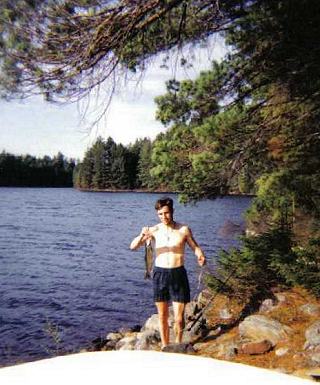 Scott’s Whiskeyjack Brookie. Day 10 – May 23 10:30 a.m. - I peeked my head out of the tent. Scott, the early riser, was already on the water. It was an overcast and cold morning, which broke our string of beautiful sunrises. Oh well, couldn't complain. After having lost a few fish and without any luck, Scott decided to head back to camp. Later on, things took a turn for the worst as I was boiling water on a flat rock next to where I sat. When it began to boil, I got up and suddenly the rock shifted, dumping the scalding hot water down my pant leg. Without hesitation, I raced down to the water .. tearing off my pants to soak it in the cold water. I was in agony and didn't move from the tent for the remainder of the afternoon. With the rest of the trip in doubt, we debated leaving immediately via the most direct route, but I decided to stick it out. I still bear the scar from this incident today. Day 11 – May 24 It was a restless and uncomfortable night. As such, I did not make any more journal entries for the trip. We broke camp early in the morning and headed back east down the Petawawa River and up through Catfish Lake. The weather turned overcast and it rained on and off, making matters worse. We decided to spend our final night in the north section of Catfish and spent most of the day in the tent, since it continued to rain. There were no more fish to speak of, as the bite turned cold just like the weather. So we explored the island. Our map indicated the presence of an “Alligator”. It was still there just as the map had shown.  Catfish Lake Alligator. Day 12 – May 25 This would be our final day in the park, after cutting the trip three days short. As we packed up our gear for the last time, we took a moment to reflect on what had been a satisfying and memorable trip. It was a long journey back to Cedar Lake and we were both relieved to finally arrive at the Brent dock. Up at the store, I took some time to sign the white board provided by the store, as we do each year, to commemorate our trip. There are boards from each year, which are nailed to the ceiling of the store. I always enjoy reading the entries .. where people are from and what their experience was like. Of course, I also reflect on our memorable “Billabong” trips of the past. The storekeeper offered us a coffee to warm up as we conversed for awhile. He also offered us the use of the shower facilities for free. Imagine that! I shall always remember this fellow for his hospitality in the true spirit of Algonquin. It was truly a great way to finish off the trip. |
||
|
Narration and photos by David Mazurkiewicz
|